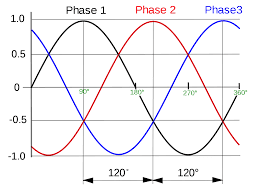Alternating Current
A.C. means alternating current -The following voltage which alternates its direction and magnitude every time. Nowadays 95% of the total energy is produced, transmitted, and distributed in A.C. supply.
Nowadays, owing to multiple systems of transmission and distribution, we come across parallel circuits such as impedance joined in parallel more often.

Practically all lighting and power circuits are constant voltage circuits which are circuits with the loads connected in parallel. In a parallel A.C. circuit like a parallel D.C. circuit, the voltage is the same across each branch. And a series circuit the current is the same across each branch also the voltage is divided.
The reason is following
- More voltage can be generated up to 33000 volts. than D.C. 650 volt only.
- AC voltage can be increased and decreased with the help of a static mechanic called the transformer.
- AC transmission and distribution is more economical as line materials say copper can be saved by transmitting power at a higher voltage.
- AC motors for the same horsepower as DC motors are cheaper, lighter in weight, require less space, and require lesser attention in operation and maintenance.
- A.C. can be converted to D.C. meaning direct current easily when required but D.C. can not be converted to A.C. so easily and it will not be economical.
- However, D.C. entails the following merits and hence finds wide application.
D.C. series motors are most suitable for traction purpose in tramway, railway, crains and lifts. For electroplating, electrolytic and electrochemical processes battery charging etc. DC is required. Arc lamps for search light and cinema projectors work on D.C. Arc welding is better than on AC.
Relay and operating time switches, etc. and circuit-breakers, D.C. works more efficiently. In rolling mills, paper mills, colliery winding, etc. where fine speed control of speeds in both directions is required, D.C. motors are required.
Alternating voltage may be generated in the following two ways.
1.By rotating a coil in a stationary magnetic field.
2.By rotating a magnetic field within a stationary coil.
A.C. series circuit
Under this heading, we shall discuss R-L and L-R series circuits.
R-L circuit
Resistance and inductance in series a pure resistance R and a pure inductive coil inductance L connected in series. Such a circuit is known as an R-L circuit.

In the circuit,
Let V is the R.M.S. value of the applied voltage,
I am the R.M.S. value of the resultant current,
Vr is IR equal to the voltage drop across the L coil, ahead of I by 90 degrees.
The voltage drop voltage resistance and voltage inductance are taken as the reference vector.
R-L-C circuit
R-L-C connected in series
In simple, An R-L-C circuit is an electrical circuit consist resistor, inductor, and capacitor are connected in series or parallel connection is generally called an R-L-C circuit.

R-resistance of the resistor, L- inductance of the conductor, C- capacitance of a capacitor is shown in fig as known as R-L-C and this three are connected in series across the voltage applied.
The resonant frequency of R-L-C circuit where L is inductance and C is capacitance.
R-L-C circuit in Parallel

R-L-C parallel connection the same of r is the resistance of resistor and L ii inductance of conductor and c is the capacitance of capacitor are connected in parallel connection as shown in the figure above. The frequency of voltage that gives the maximum value of the current in the circuit is called resistance frequency, and the circuit is said to be resonant.
Alternating Current – Definition, Working Principle, AC Generator
alternating current (AC) is an electrical current that periodically reverses direction, in contrast to direct current (DC) which flows in only one direction. The voltage and current in an AC circuit oscillate in a sinusoidal waveform.
The working principle of alternating current is based on the fact that the voltage and current in an AC circuit are constantly changing direction. This is achieved through the use of an AC generator, which uses mechanical energy to generate an alternating current.
An AC generator, also known as an alternator, is a device that converts mechanical energy into alternating electrical energy. It works on the principle of electromagnetic induction, discovered by Michael Faraday in 1831. An AC generator has a rotor (rotating part) and a stator (stationary part). The rotor is connected to a prime mover, such as a steam turbine or internal combustion engine, which supplies the mechanical energy. The stator contains a set of coils, which are magnetized by the rotor’s motion. As the rotor turns, it induces an alternating current in the stator coils. The frequency of the alternating current is determined by the speed of rotation of the rotor.
In summary, Alternating current (AC) is an electrical current that periodically reverses direction and AC generators are devices that convert mechanical energy into alternating electrical energy using the principle of electromagnetic induction.
Related Topic – click here
- What Is Alternating Current? | AC Current, A.C. Series Circuit
- Corona Discharge | Problems Caused By Corona Discharge
- What Is The Difference Between Earthing, Grounding, And Neutral?
- Kirchhoffs Circuit Laws
- Electronics-Semiconductor Device | Semiconductor Device Example
- The 5 Common Insulating Materials | Materials Used For Insulation
- 4 Main Types Of Insulators Used In Overhead Lines | Types Of Insulators Used In Transmission Line
- Electrical Transformers | Use Of Power Transformer





